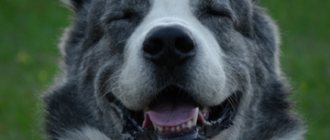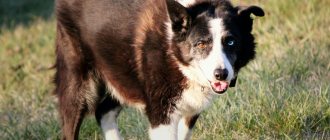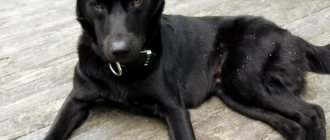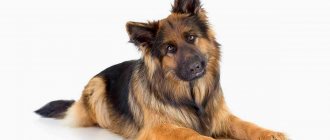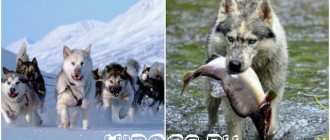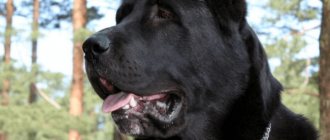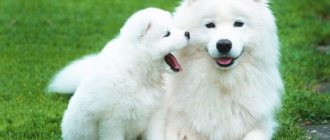Black color has become a classic color for German Shepherds. Black-and-tan “Germans” are shown in advertising, at exhibitions and even in feature films, and most people associate shepherd dogs with the saddleback color. However, this was not always the case - after all, the breed of black and red “Germans” is just over a hundred years old! In our article we will learn the history of the origin of the breed, and also consider the main features of black-haired German shepherds.
History of the origin of the breed
Initially, the black-and-white color did not exist in shepherd dogs, although due to natural evolution, black-and-red dogs could exist as isolated random individuals. Among the ancestors of the German Shepherd, individuals with black, zone and black and tan shades dominated. The ancestors of modern "Germans" were used by people as guard and herding dogs that kept a pack of animals together. Shepherds loved the breed for its high intelligence, friendly nature and ability to fend for itself.
The familiar black-and-white German Shepherd appeared a little over 100 years ago in Germany through the efforts of the famous dog breeder Max von Stephanitz. Initially, the breed was dirty white in color, but over time, von Stefanitz achieved the consolidation of the black-backed color in dogs. The breed standard was established in 1899 among other dog breeders, which has remained virtually unchanged since then. A few words about the development of the breed in the 20th and 21st centuries:
- At first, the Black-backed German Shepherd was used to guard herds of animals during grazing. However, at the beginning of the 20th century, animal breeding technologies changed significantly, so the need to protect large herds disappeared. Therefore, many people began to think about alternative ways to use a dog.
- A solution was found quickly. People have noticed that the German Shepherd is distinguished by its developed intelligence and high ability to train. Therefore, animals began to be actively used for security or police purposes - searching for criminals, searching for dangerous or prohibited substances.
- In 1914, the dog began to be used in the army, and the German Shepherd took part in the First and Second World Wars, becoming an indispensable companion for soldiers. After the war, the dog began to be used in local conflicts, as well as in the police to perform standard functions - searching for things and people, protecting objects, etc.
- After World War II, ordinary people began to own German Shepherds. The dog became a friend for many people who received a faithful, kind animal with high intelligence and good learning ability. The dog began to be used for advertising; it became a character in a number of feature films.
- At the beginning of the 21st century, there was a split among dog breeders into two camps. Representatives of the first camp when breeding focus on the appearance of the dog, which allowed them to preserve the sable color, but worsened the physical and mental health of the breed. Representatives of the second camp are more concerned with utilitarian functions, and the issue of color is of little concern to them. Time will tell which position will win.
Attention! Representatives of the first camp call themselves supporters of exhibition breeding, while representatives of the second camp call themselves supporters of working breeding.
Description
So, we have briefly reviewed the history of the breed - let's now move on to the question of the description and psychological characteristics of the black-haired German shepherd. We will consider the color features in a separate paragraph.
Dimensions
The black-haired German Shepherd is a dog of medium height with a slightly elongated body, dry bones and developed muscles. The average height of an adult dog is 55-65 centimeters (at the withers), length - 70-80 centimeters for males and 65-75 centimeters for females. Although the body shape is elongated, it does not look squat. The length of the head is 35-40% of the height at the withers. The head is wedge-shaped, and males have a more massive muzzle than females. Other features of the breed:
- The black-backed German Shepherd's ears are erect and of medium size. Their shape is triangular, and the tips of the ears are rounded.
- The eyes are oval in shape and dark in color. The look is smart and slightly wary. The nose is large or medium in size, and it is painted in a dark color.
- The neck is located at an angle of 45 degrees relative to the body and has developed muscles (although this is difficult to notice under a layer of fur).
Weight
Weight is also subject to sexual dimorphism: the mass of males will be 30-40 kg, while females will be 20-30 kg. There are also large representatives of the breed, whose weight can reach 45-50 kg. Weight is affected by lifestyle, diet, and age of the animal:
- In middle age, with an active, balanced diet, the animal’s weight will be within the normal range (30-40 kg for males and 20-30 kg for females). In old age, animals lose a little weight, but weight loss should not exceed 10-20%.
- If there is an excess of food, fat will accumulate on the body, which will lead to an increase in live weight. Obesity is usually diagnosed at a weight of more than 45 kg for males and 35 kg for females, although there are large representatives of the breed for which this may be normal.
- Active dogs are less likely to suffer from obesity, even if there is an excess of food. Excess calories are spent on active activities, which prevents fat deposition. Staying at home all the time is a significant risk factor for the development of obesity. Therefore, such animals need to reduce their diet by 15-30%.
Character of dogs
The black-backed German Shepherd is an intelligent, attentive animal that is strongly attached to its owner. She is well treated by her owner, family members and regular friends. She distrusts strangers, and if they show aggression, she can fight back. The animal has developed intelligence, so it is easy to train. Although it is recommended to start training at an early age, when the dog’s mind is most developed. Black-backed German Shepherds are versatile animals that can be used in different capacities:
- Companion dog. You can take the animal with you for a walk, and after the walk is completed, the dog can be left in the yard or allowed into the apartment. A dog rarely damages furniture and household items.
- Guard dog. The German Shepherd can be used to guard various objects - from private houses to large warehouses. To increase the effectiveness of protection, it is recommended to train the animal.
- Guide-dog. After training, the dog can be used as a guide dog. Therefore she will be a friend to blind people.
- Service dog. German Shepherds are used by the police to find and pursue people suspected of committing crimes. They can also be used to search for prohibited substances and security.
Attention! The German Shepherd gets along well with children and pets, and they can only bite a stranger for the purpose of self-defense.
Features of color
Dogs of this breed have a saddle (red and black) color. Ideally, a “saddle blanket” is a color with a V-shaped dark spot on the dog’s back, which runs from the ridge to the belly. The dark patch often extends to the sides and can extend down to the dog's elbows. Other parts of the body are tan or brownish-orange with gray and white markings (the white fur is usually concentrated on the belly or sternum area).
The dog has a characteristic black “mask” on its face, which usually extends only to the nose, eyes and area around the mouth. Some dogs may have a narrow, long black stripe on their sternum that resembles a human tie. Many Shepherds have one or more black moles on their faces, although many members of the breed may not have them (the breed is determined by pedigree, not the presence of moles).
Grey
Greek and Central Asian, South Russian Shepherd Dogs, Briard - these are the breeds that can have a gray color.
An interesting breed is the Puli, which comes in white, gray, and other colors.
Puli dog
The fur is formed into cords that completely hide her brown eyes. Puli is a very smart and loyal, but also a serious dog.
If she thinks her owner is in danger, she will attack without warning.
The Catalan Shepherd is found in both gray and other colors.
Catalan Shepherd
Her coat is hard, with a thick undercoat, the dog is decorated with a lush collar, mustache, beard, and bangs. The wool is long.
The dog's appearance is very funny, and his character is energetic and cheerful.
The Romanian Mioritic Shepherd is massive, covered with thick white or fine hair, sometimes with different spots. She is surprisingly obedient and extremely affectionate.
Romanian Mioritic Shepherd Dog
Only the owner himself can train her: she “falls in love” with only one person, once and for all. The Romanian Shepherd will never betray its owner, even if he is no longer there.
Black-backed German Shepherd puppies
Pregnancy in female German Shepherds lasts 60-65 days. The number of puppies in a litter is not strictly fixed and can range from 1 to 15 individuals (usually a female gives 8-10 puppies). Puppies are born deaf and blind, but by the second week of life they gain both hearing and sight. Females have a well-developed maternal instinct, so the dog breeder will have no problems taking care of the offspring.
Puppies look like clumsy bear cubs - they are quite large in size and have a somewhat angular body shape. Healthy puppies quickly get on their feet, and after acquiring hearing and vision, they begin to navigate well in the surrounding space, so they do not require human help. Puppies are actively exploring the world and can get into mischief, so it is recommended to keep a little eye on them.
Other features of the puppies:
- In the first months of life, it is not recommended to separate animals from their mother, although petting and caring for animals is allowed. Animals should be separated from their mother at the age of 2.5-3 months, since in this health they have strong immunity and can take good care of themselves.
- It is recommended to begin training the animal immediately after weaning from the mother. At a young age, puppies learn quickly and remember commands well, which will help with training the animal. Theoretically, you can train a shepherd at any age, but the later you start, the worse the results will be.
- Newborn puppies have drooping ears, which indicates the health of the animal. By 2-3 months of life, cartilage tissue forms in the ears, so they acquire a “standing” shape. If the ears of a newborn puppy are erect, this indicates an abnormal calcium-phosphorus metabolism (consultation with a veterinarian is required).
How many months should ears stand?
Small puppies' ears look disproportionately large. From 2 months to 4 months of age, the German Shepherd's body actively produces elastin and collagen, so the ears grow much faster than other parts of the body. They become heavy and large. From two to six months they begin to stand up - first in a “house”, “cap”, they can fall to one side, rise and fall again. By 5 months of age, the structure of the auricle reaches its maximum density, the ear stops growing and stands up completely. If this does not happen, the reason may be:
- lack of minerals in the diet;
- ear pathologies;
- weak immunity;
- the shepherd is not purebred;
- individual characteristics of the puppy.
Health and life expectancy
With proper care, the animal can live 13-15 years. By nature, black-haired shepherd dogs are distinguished by good health, but they still suffer from some diseases:
- Gastrointestinal diseases. The appearance of disorders is associated with the structural features of the gastrointestinal tract of dogs. To minimize the risk of disorders, it is necessary to feed animals a healthy diet or high-quality feed. Feeding should be done according to a schedule, and at least 3 hours should pass between meals and bedtime.
- Allergic reactions. The disorder usually appears due to eating uncharacteristic foods that are poorly digested by the gastrointestinal tract. The main recommendations for reducing the risk will be standard - dogs need to be fed healthy food or good food, at least 3 hours should pass between sleep and meals, and so on. You also need to teach your dog not to pick up food on the street.
- Hip dysplasia. The disease is typical for dogs of large and medium breeds, which is associated with the structure of the animals’ bones. If the disorder is detected at the initial stage, the disease can be easily treated with a simple operation. In adult dogs, the disorder is poorly treated, although surgery can alleviate the symptoms of the disorder.
Attention! It is recommended to take puppies to the vet every three months until they are 1.5 years old. After this, adult dogs should be taken to the veterinarian for an annual checkup.
Care and maintenance
Black-backed German Shepherds are undemanding in care and can easily cope with life both in the house and outside in the yard. They eat almost any food - from boiled cereals to meat and even vegetables. Veterinarians recommend giving preference to meat foods, as this will have a good effect on the growth of the animal. Shepherds can also eat food, but it is not recommended to buy cheap food with questionable composition. It is recommended to give food 3-4 times a day, and the amount of food per day is 0.8-1.2 kg, depending on the type of food, size and age of the animal.
Additional tips for care and maintenance:
- If kept at home, the animal must be walked at least 2 times a day at regular intervals. If there is a walk, the animal will not mark the territory and shit in the apartment.
- The dog will shed frequently, and due to its large size, you will end up with a lot of hair on the floor and furniture. To solve this problem, it is recommended to comb the animal at least 2-3 times a week.
- Also buy a special brush and toothpaste for the animal, and brushing its teeth should be done every day. You also need to clean your animal's ears 1-2 times a week.
Two main types
To facilitate classification, the colors of dogs are usually divided into monochromatic and multi-colored. Each type is divided into several categories.
Single color
Dogs with evenly colored fur are called plain and are divided into several types.
Single color:
- Dark. All shades of dark wool arise under the influence of a special pigment - eumelanin. How dark the hair turns out depends on its concentration. If the coat is dark brown or black, there is a lot of eumelanin. If the fur coat looks beige, there is little pigment. By the way, experienced breeders assure that pure black color does not exist in nature. It's just a concentrated brown, close to black.
- Light. The shade of light fur is determined by the presence of the pigment pheomelanin. Large amounts of it will produce a yellow or fawn color. A small concentration will color the dog in sandy shades.
- Albino. This color looks white, but is actually colorless. There are very few true albinos in nature.
Multicolor
The concept of multicolor includes combinations of different shades, as well as patterns on the dog’s coat. These colors are divided into several types:
- Motley. The body of the animal is painted in the main color, but there are small inclusions of other shades on it. Often, small light areas consisting of several hairs are indicated on a dark background. This color may appear as a gray, piebald or speckled pattern.
- Marble. This coloring is often called “harlequin”. Typically, it is a white or light background with small dark markings. The points do not have smooth edges and are located chaotically.
- Black-and-white. Another name for the color is fawn. This is a red color, with a shade reminiscent of sand. At the same time, the color intensity is different in different parts of the body. The upper body is darker, and the lower body, belly and paws are much lighter.
- Tan. The color of the animal's body can be any color. There are brown, gray and almost black dogs with contrasting tan marks. As a rule, marks are localized on the muzzle (eyebrows), in the larynx, on the cheekbones, as well as on the paws and tail.
- Zoned gray coloration. The so-called wolf color is characterized by a light background, on which yellow, black and light areas are clearly distinguished.
- Brindle. This color is presented in the form of transverse dark stripes on a brown or sandy background. The body must be in warm shades - yellowish, red, red. A gray background is extremely rare, but is not considered a flaw, just like the presence of white points. The stripes on the animal's body form rings that are torn in the abdominal area. Often these colors have a dark mask on the face.
- Roan. Amazing coloration of wool, when individual colorless hairs appear against a uniform background. This inclusion creates a silvery shine effect.
In addition to solid and spotted colors, there are also patterns. A pattern is the coloring of certain areas of the body or the presence of a regular pattern. This could be streaking, scooping or scorch markings.
Education and training
The animal lends itself well to training, and it is better to start training from an early age (a good option is immediately after weaning from the mother). Basic instructions regarding training:
- Young dogs are able to learn simple commands in a few repetitions, and training is recommended in a playful way. For successful execution of the command, you need to give the dog his favorite food (for example, food or a small piece of meat).
- Before training, you need to give the animal a nickname, and in order to reinforce the response, you need to constantly call the animal by its nickname. When the animal learns its name, it is necessary to learn the basic simple commands - “Come to me”, “Give me a paw”, “Sit”, “Fu”, “No” and others.
- The animal must have a special place in its house where it will rest. The area may contain a pillow, blanket, and a few of your pet's favorite toys. Such a place cannot be moved frequently - otherwise the animal will quickly lose interest in it.
How to choose a Black Sheepdog
Beginner shepherd lovers are advised to buy a small puppy. Although experienced breeders can take an adult. Guidelines for choosing a puppy:
- When purchasing an animal, be sure to study the documents for the animal. They must confirm the quality of the breed for the mother and father. When purchasing without documents, there is always a high risk of running into scammers selling out-of-breed “crossbreeds”.
- A big plus will be that the mother and father of the puppy have medical certificates confirming their state of physical and mental health. Remember that many traits are inherited, so if the father/mother has congenital disorders, you should avoid buying a puppy.
- When choosing, also pay attention to the condition of the puppy itself. He should be active and moderately well-fed, which indicates a state of health. If you are offered to choose one of several puppies, then buy a dog that actively makes contact.
What you need to know before the inspection
Before choosing a puppy, it is recommended to find out a number of important questions that will help you avoid making the wrong decision. You should find out how many times a year a bitch gives birth - you should not take babies from one that does this more often than once a year. Practice shows that if childbirth occurs more than once a year, the mother does not have time to gain strength to bear a full-fledged offspring.
There should be no more than ten puppies in the litter - otherwise the mother does not have enough milk and internal resources to bear them well. Also take a look at what the babies look like - they should be approximately the same size, naturally taking into account the fact that a female shepherd puppy is always smaller than a male.
Price range
The cost of a healthy “German” is 25-50 thousand rubles for puppies and 10-20 thousand for adults. You can adopt a dog for a small price in private or municipal shelters, although you will have to tinker with new shepherd dogs quite quickly, so you will have to look for news on new dogs. The cost of the animal is affected by the following parameters:
- Pedigree. The better the dog’s pedigree, the higher the cost of the final litter. Pedigree dogs in good health can cost up to 100 thousand rubles.
- Color. The sable color has a certain variability, and some color options may confuse new breeders. Therefore, the cost of puppies with the “stereotypical” saddle color will be higher.
- Floor. Females are 20-30% more expensive than males. This is due to the fact that females are often bought for breeding, which creates additional demand for them.
Attention! When buying a dog, be sure to take the documents for the animal in case of further breeding.
Tags
Black-and-white color in Black-and-white color Uzonary color New color of quick-black color. Black-and-white color. so that a shepherd dog can be a real shepherd. A shepherd dog must have a saddle coat. Black-colored ancestors of black-haired shepherds.shepherds of black-haired color.shepherds of black-colored color.time black-haired color Dogs Dog breeds Dogs zonal color Zoner same ZONARY color.essence. Zonal ones are colored by zonal ones. Zoned color why zoned puppies
answeringcatscats
Recommendations
In conclusion, let's look at a few general recommendations:
- It is not recommended to buy an adult dog for your apartment if you already have other animals (for example, cats or other dogs). There is always a risk that the animals will not make friends, which will turn your life into a nightmare. Therefore, check with the seller in advance whether it is possible to return the dog if it does not make friends with other animals.
- It is recommended to consult a veterinarian regarding food, since there are many expensive but low-quality foods on the market today. If you eat poor food, the risk of developing gastrointestinal diseases and allergies significantly increases, so it’s not worth the risk.
In conclusion, many people take two puppies at once so that the dogs do not get bored. This approach is correct, but keep in mind that two shepherd dogs will play and run around the house a lot, which can lead to damage to furniture, appliances and flooring. Therefore, it is recommended to take very calm puppies so that your home can survive. If you live in a house, then this problem is not critical - after all, puppies can be kept outside during the warm season.
Non-standard suits of the “Germans”
The following colors of German Shepherds are rare. All of them are considered marriage. Such dogs are not allowed for exhibitions or breeding. But if you need an unusual pet-class puppy, then there are no barriers to getting a four-legged friend with a unique coat color. It does not affect the health or character of the pet in any way.
Let's look at the rarest colors of "Germans" with photographs and brief descriptions.
White
Light-colored puppies appear if both parents display the recessive gene responsible for this color.
Individuals with a white color are not albinos. They have a black nose, dark eyes and claws. But they are rejected.
Red (yellow)
Another non-standard look. Red dogs look impressive. However, this is a deviation that is not recognized by kennel clubs. At the same time, red tan or zone-red color is allowed.
Grey
It is also called blue. It appears as a result of a weakening of the black color. Dogs of this type are culled.
Golden
A variety of non-standard red color. Occurs when a certain pigment is present. The coat of these “Germans” is light, almost golden in color.
Spotted
The fur coat of spotted German Shepherds seems to be covered with multiple pigment spots. They are found throughout the body and are scattered unevenly in different areas. As a rule, such dogs are mestizos of shepherds and mongrel dogs.
Roan
Sometimes, with age, a “German” can turn gray. More and more light hairs and fewer and fewer dark ones will appear on the fur coat. When gray hair begins to predominate, we can talk about a roan color.
No matter how much you would like to get a German Shepherd of an unusual color, it is worth remembering that such an animal is not recognized as a standard. It can only be kept as a pet.
If you plan to participate in exhibitions or breed, you must take a “German” of an acceptable color. Moreover, there is enough diversity even among standard types.
